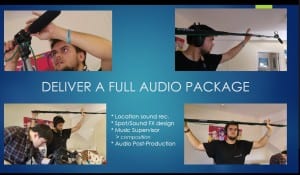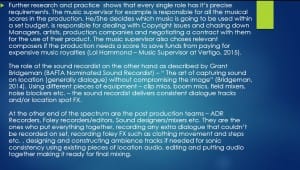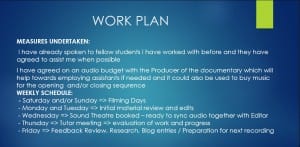On the 16th of November 2015 we received a guest lecture by Dan Shepherd – BBC radio programme producer and founder of Far Shoreline Productions. In his lecture he focused on the production of feature programmes for radio. He explained that the feature could be explained as a documentary but there is a difference – radio documentaries specifically tend to be more journalistic (i.e covering current events/news leads), a radio feature on the other hand allows you to explore an idea, a convention, a person and most importantly it provokes your imagination through sound (sound effects/adding music to the feature etc.). Shepherd also touched on the difference between a presenter lead feature and a montage – the presenter lead style is self explanatory: it includes a presenter who leads a panel of guests, dictates the pace of a debate/discussion and most importantly clarifies all the information to the listeners. The montage consists of many recordings put together to tell a story or to inform/grab the listener’s attention without the assistance of a presenter/narrator.
In the lecture we discussed some of his productions for the BBC. We were given the opportunity to ask him questions about his travels and about the ways/techniques he used to produce content for an organization of this variety. He also gave us some advice about project researching and pitching, and also pointed out that things go wrong quickly – quick adaptation is key (similarly to what Bryan Rudd talked about in a previous guest lecture) – (LO5).
Mihail Sustov
19/10/2015 Project Case Study – Bryan Rudd
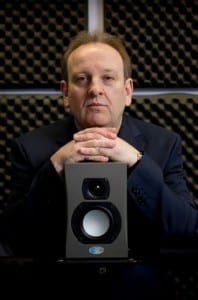
On the 19th of October we had a lecture by Bryan Rudd. His focus was on the importance of project management and the ability to adapt quickly to any given situation/problem that might occur during a project. He spoke about a specific case study – Producing “Chronicles of Freedom” – a radio drama project which he took over with little time to spare until the completion deadline. The main issues with the project were Problem and Time management on a tight schedule. Bryan Rudd pointed out that there are a few questions that we have to ask ourselves in similar and/or generally other situations –
1. WHAT is the problem and WHY is it a problem?
2. What choice do I have and what difference will my decisions have in the short/medium/long term?
And finally
3. Reflections and Further Adjustments
These could be very useful if there were problems during the audio production for my group’s project – (LO5)
The outcomes of Bryan’s experience were that we should always aim to work in advance – i.e have content ready for editing/mixing etc. at least 2 weeks before the given deadline. He also suggested that having a second opinion on the progress of the product and on the final piece always helps as others will approach it with a “fresh set of ears” and will give you valid feedback which you could take into consideration before you submit the project. Furthermore he emphasized on the importance to seek help if needed – we shouldn’t take on more jobs than we can handle, but if we do bite off more than we can chew sharing the workload with an assistant/casual helper will greatly impact the project (in a good way) (LO5). Another important prat in project management is also not being afraid to put our foot down when dealing with others from the production team – if we think we are correct and that our opinion will impact the better development of the project in a positive way then we should stand up for it.
In conclusion Bryan Rudd’s lecture was very helpful in a sense that I gained a bit more insight into project management and how to deal with pending issues and unexpected occurrences. His advice will most certainly come in handy during the production and post production processes (LO4) (LO5).
Jez Riley French 02.11.2015
On the 2nd of November 2015 we had a guest lecture from sound recordist Jez Riley French.
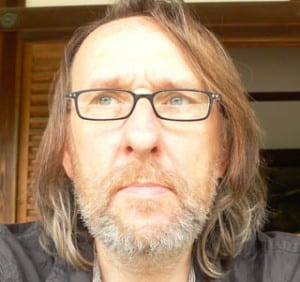
He practices in the field of unconventional sound recording, composition & publishing etc. – he builds/creates and uses contact microphones
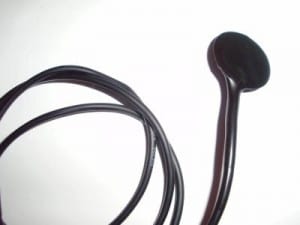
, hydrophones
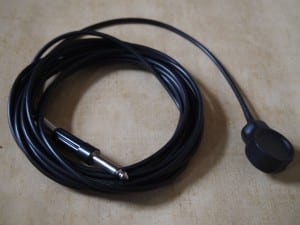
and other types of microphones which capture interesting and unorthodox sounds, (mainly vibrations), which could easily be applied to anything from video game SFX to diverse ambiances in film, TV and many more. By demonstrating his recordings he explained to us the various techniques that he uses to record interesting sounds such as recording rain tapping on a window with a contact microphone, or the melting of ice with a hydrophone as well as underwater vibrations. He later spoke about the importance of having proper equipment on which to listen back to the recordings as it is of great importance to be able to experience these unconventional sounds to their best extent. Furthermore he gave advice on using EQ in any DAW when working with natural sounds also warning/raising awareness about pre-amp noise/hum during recording. Most importantly he said that using too much EQ in post production destroys the nature of the sound itself/ the sound loses it’s natural sound and is ruined. The advice he gave about avoiding such harsh equalization was to make sure all field recordings are as clean as possible (avoid using phrases like we’ll fix it in post etc.).
What I learned from this lecture was that there are many more interesting ways to record out there. Using contact microphones and hydrophones one can get very interesting and widely applicable sounds, and also that it is of great importance to record location sound as clean and as natural as possible to preserve the character of the sound. (LO1) These outcomes will come in very handy when I am recording on location again (not only for Audio Project 1 but for the future as well) and also in post production when I am deciding on EQ’s and edits. All in all a great and informative lecture.
LEARNING OUTCOMES REVISED
- (LO1) By the end of this project I will be able to successfully recognize and utilize location sound recording techniques determined by the location itself, common industry practices and the nature of the recording.
- (LO2) Furthermore I will be able to produce an audio package for a specific audience/type of production – Documentary
- (LO3) I will also be able to manage a specific music budget and to comply with professional contexts – copyright, clearances, legal and ethical issues.
- (LO4) I will be able to evaluate my own work and reflect on how it adheres to specific requirements and/or what I could do/could have done to make it better.
- (LO5) I will be able to address issues and problems that might occur during the production process accordingly by good time management (considering a safety period in case something goes wrong) and a set work/job schedule – including asking for assistance where needed.
- (LO6) I will be able to take other opinions into consideration during the post-production process. By receiving a different perspective on “the work in progress” it will help me produce consistent audio informed by the opinions of members of the audience (listeners, viewers etc.).
Project Presentation/Tutor Meeting – 15.10.2015
On the 15th of October during my weekly tutor meeting I presented my project to my supervisor. Outlining all of the roles involved in audio pre and post – production, my role specifically issues and problems + solutions. I also proposed a weekly workplan which got approved by my supervisor.
Slides from the presentation:
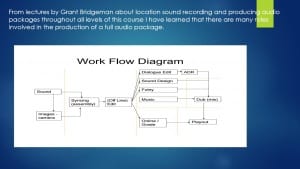
Film sound recording and design is effectively broken down into five key phases:
1. Research and study of the script, consultation with the director and producer (LO1) + (LO2)
2. Field and Location recording (LO1) + (LO2)
3. Sound effects
4. Building and operating a Foley sound stage (LO1) + (LO2) – (side note: not particularly necessary for our Documentary production but still useful in case the Director decides to include foley in the production)
5. Digital post-production, sound design, multi-track layering and mixing with musical composition, and final mix-down. (LO1) + (LO2)
(Crook, 2012; 173)
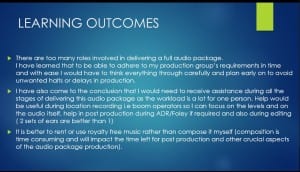
“It is recommended that you produce sound for film in a team as the technical and creative demands of film operate on an industrial scale of production” (Crook, 2012; 172).
I also provided rough-cut samples with synced and slightly edited audio from the first shoot on location. My supervisor was satisfied with the recordings and with the progress. As this was a interview shoot and future recordings will include interviews he suggested adding one more microphone to the person who is asking the questions which is sending signal to a spare Zoom H4n just in case if we need to put the question in the mix. This way I will have clearer audio with better levels and less noise from the person asking the question on location in stead of doing it as ADR later in post (which would be time consuming). Such techniques will be very useful during the next location recording as it will be done in quite a noisy environment. As preparation I have also ensured that I have a wind jammmer and noise isolator for the boom.
During the meeting we also discussed the distribution of the negotiated budget for audio. My supervisor also helped me find examples of sources I could use to find high quality affordable music and audio for the opening and closing sequences.
It was a very productive meeting – I presented the project and received feedback straight away after the presentation which was more than useful. It helped me figure out what I’m doing right and what I could improve on right away. The tips I received about recording interviews will also come very handy in the preparation for the next location shoot which will be on the 24th and 25th of October in London at the MCM Comic Con.
